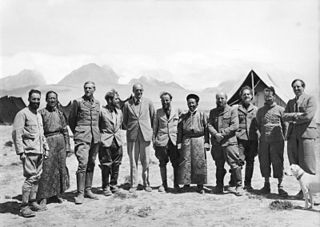
Tibet is a region in East Asia, covering much of the Tibetan Plateau and spanning about 2,500,000 km2 (970,000 sq mi). It is the traditional homeland of the Tibetan people. Also resident on the plateau are some other ethnic groups such as Monpa, Tamang, Qiang, Sherpa and Lhoba peoples and now also considerable numbers of Han Chinese and Hui settlers. Since 1951, the entire plateau has been under the administration of the People's Republic of China, a major portion in the Tibet Autonomous Region, and other portions in the Qinghai and Sichuan provinces.

Bon or Bön, also known as Yungdrung Bon, is a Tibetan religious tradition with many similarities to Tibetan Buddhism and also many unique features. Bon initially developed in the tenth and eleventh centuries, but may retain elements from earlier religious traditions. Bon remains a significant minority religion in Tibet and in the surrounding Himalayan regions.

While the Tibetan plateau has been inhabited since pre-historic times, most of Tibet's history went unrecorded until the introduction of Tibetan Buddhism around the 6th century. Tibetan texts refer to the kingdom of Zhangzhung as the precursor of later Tibetan kingdoms and the originators of the Bon religion. While mythical accounts of early rulers of the Yarlung Dynasty exist, historical accounts begin with the introduction of Buddhism from India in the 6th century and the appearance of envoys from the unified Tibetan Empire in the 7th century. Following the dissolution of the empire and a period of fragmentation in the 9th-10th centuries, a Buddhist revival in the 10th–12th centuries saw the development of three of the four major schools of Tibetan Buddhism.

The Tibetan independence movement is the political movement advocating for the separation and independence of Tibet from the People's Republic of China. It is principally led by the Tibetan diaspora in countries like India and the United States, and by celebrities and Tibetan Buddhists in the United States, India and Europe. The movement is no longer supported by the 14th Dalai Lama, who although having advocated it from 1961 to the late 1970s, proposed a sort of high-level autonomy in a speech in Strasbourg in 1988, and has since then restricted his position to either autonomy for the Tibetan people in the Tibet Autonomous Region within China, or extending the area of the autonomy to include parts of neighboring Chinese provinces inhabited by Tibetans. Additionally in 2017, the Dalai Lama asserted that Tibetans wanted to stay with China, and that they want more development from China.

Jelep La elevation 14,390 feet (4,390 m), is a high mountain pass between Sikkim, India and Tibet Autonomous Region, China. It is on a route that connects Lhasa to India. The pass is about 4 km (2.5 mi) south of Nathu La and is slightly higher. It was frequently used for trade between Tibet and India during the British Raj, with Kalimpong serving as the contact point. The Menmecho Lake lies below the Jelep La.

Lobsang Trinley Lhündrub Chökyi Gyaltsen was the tenth Panchen Lama, officially the 10th Panchen Erdeni, of the Gelug school of Tibetan Buddhism. According to Tibetan Buddhism, Panchen Lamas are living emanations of the buddha Amitabha. He was often referred to simply as Choekyi Gyaltsen.

The Tibet national football team is a football team that represents the cultural region of Tibet in non-FIFA international tournaments, and is organised by the Tibetan National Football Association (TNFA), an organisation of exiled Tibetans.

The British expedition to Tibet, also known as the Younghusband expedition, began in December 1903 and lasted until September 1904. The expedition was effectively a temporary invasion by British Indian Armed Forces under the auspices of the Tibet Frontier Commission, whose purported mission was to establish diplomatic relations and resolve the dispute over the border between Tibet and Sikkim. In the nineteenth century, the British had conquered Burma and Sikkim, with the whole southern flank of Tibet coming under the control of the British Indian Empire. Tibet ruled by the Dalai Lama under the Ganden Phodrang government was a Himalayan state under the suzerainty of the Chinese Qing dynasty until the 1911 Revolution, after which a period of de facto Tibetan independence (1912-1951) followed.
The Tibetan sovereignty debate refers to two political debates. The first political debate is about whether or not the various territories which are within the People's Republic of China (PRC) that are claimed as political Tibet should separate themselves from China and become a new sovereign state. Many of the points in this political debate rest on the points which are within the second historical debate, about whether Tibet was independent or subordinate to China during certain periods of its recent history.

Hugh Edward Richardson was an Indian Civil Service officer, British diplomat and Tibetologist. His academic work focused on the history of the Tibetan empire, and in particular on epigraphy. He was among the last Europeans to have known Tibet and its society before the Chinese invasions which began in 1950.

The 1938-1939 German Expedition to Tibet, a German scientific expedition, took place between April 1938 and August 1939 under the leadership of the German zoologist and SS-officer Ernst Schäfer.

Patrick French is a British writer, historian and academician. He was educated at the University of Edinburgh where he studied English and American literature, and received a PhD in South Asian Studies. He was appointed as the inaugural Dean of the School of Arts and Sciences at Ahmedabad University in July 2017.

Sir Charles Alfred Bell was the British Political Officer for Bhutan, Sikkim and Tibet. He was known as "British India's ambassador to Tibet" before retiring and becoming a noted tibetologist.
The serfdom in Tibet controversy is a prolonged public disagreement over the extent and nature of serfdom in Tibet prior to the annexation of Tibet into the People's Republic of China (PRC) in 1951. The debate is political in nature, with some arguing that the ultimate goal on the Chinese side is to legitimize Chinese control of the territory now known as the Tibet Autonomous Region or Xizang Autonomous Region, and others arguing that the ultimate goal on the Western side is to weaken or undermine the Chinese state. The argument is that Tibetan culture, government, and society were barbaric prior to the PRC takeover of Tibet and that this only changed due to PRC policy in the region. The pro-Tibetan independence movement argument is that this is a misrepresentation of history created as a political tool in order to justify the Sinicization of Tibet.
Human rights in Tibet is a contentious issue. Even though the United States advocates the human rights of the Tibetan people and even though it once provided funds to the Dalai Lama's independence movement, the United States does not participate in the Tibetan sovereignty debate and as a result, it does not recognize Tibet's right to exist as a country. Reported abuses of human rights in Tibet include restricted freedom of religion, belief, and association; arbitrary arrest; maltreatment in custody, including torture; and forced abortion and sterilization. The status of religion, mainly as it relates to figures who are both religious and political, such as the exile of the 14th Dalai Lama, is a regular object of criticism. Additionally, freedom of the press in China is absent, with Tibet's media tightly controlled by the Chinese leadership, making it difficult to accurately determine the scope of human rights abuses.

Theos Casimir Hamati Bernard (1908–1947) was an explorer and author, known for his work on yoga and religious studies, particularly in Tibetan Buddhism. He was the nephew of Pierre Arnold Bernard, "Oom the Omnipotent", and like him became a yoga celebrity.
Buddhists, predominantly from India, first actively disseminated their practices in Tibet from the 6th to the 9th centuries CE. During the Era of Fragmentation, Buddhism waned in Tibet, only to rise again in the 11th century. With the Mongol invasion of Tibet and the establishment of the Mongol Yuan dynasty (1271–1368) in China, Tibetan Buddhism spread beyond Tibet to Mongolia and China. From the 14th to the 20th centuries, Tibetan Buddhism was patronized by the Chinese Ming dynasty (1368–1644) and the Manchurian Qing dynasty (1644–1912) which ruled China.
Prostitution in Tibet is thought to have existed for centuries. Testimonies of its existence were provided by outside visitors in the first half of the twentieth century. According to the British writer Christopher Hale, due to the practice of polyandry in Tibet, many women were unable to find a husband and moved to villages and towns, where they fell into prostitution. Their clients came from the caravans crossing the Tibetan plateau, and also from the monasteries.
Tibetan Review is a Tibetan monthly journal and news website published in English, based in Delhi, India. It was first published in Darjeeling, West Bengal in April 1967 by Lodi Gyari. It is well known for its open and vibrant democratic forum for the discussion of the Tibetan problem and other related governmental and social issues on Tibet.

A Historical Atlas of Tibet is an atlas and a topographical book by Karl E. Ryavec.













